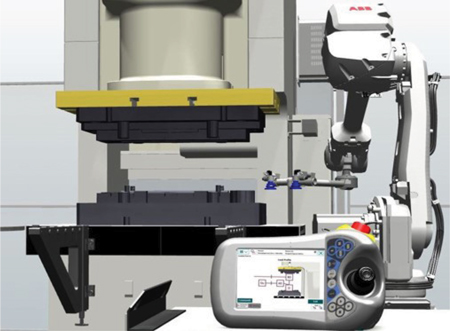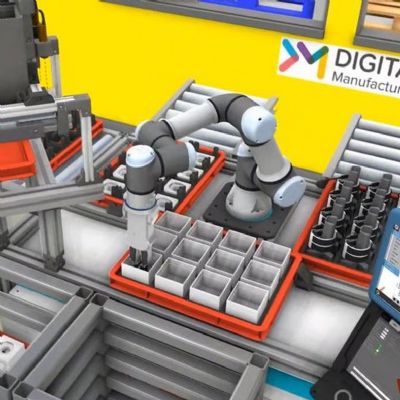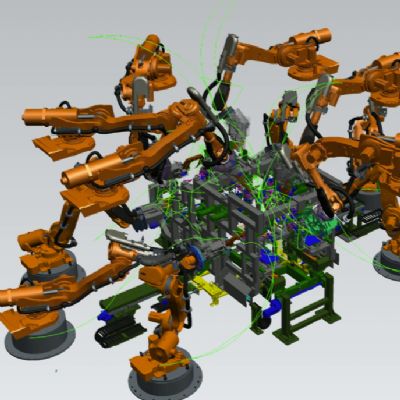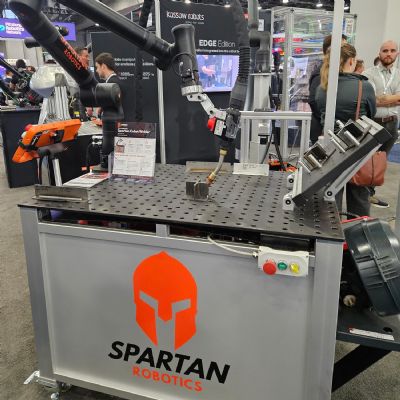Remote Testing, Simulation Cut Integration Time, Cost
While adding robots to a press line or workcell always will require physical installation of equipment, mechanicals and cabling, the advent of integration software and simulation, along with offline programming, has reduced integration from weeks for small and medium-sized projects to only a couple of days in many cases.
Advances in computing power bring the ability to offer sophisticated software that trials robot integration into press lines and workcells without causing downtime and necessitating time-consuming onsite work, with all of the associated costs. Roda cites ABB’s RobotStudio as an example. The computer-based programming system, showcased by ABB at FABTECH 2019, allows programming to be performed on a computer without disturbing existing production. Integrators can communicate with customers and involve them closely through all phases of robot integration, from design through commissioning, according to ABB officials, resulting in more quickly designed systems and higher productivity. Built on the ABB Virtual Controller, an exact copy of the real software that runs robots in production, RobotStudio reportedly ensures that everything in the virtual world works exactly how it will in the real world, by using real robot programs and configuration files identical to those used on the shop floor. Realistic graphics display tooling, movements and throughput, enabling users to verify tooling, cycle times, work envelopes and product throughput before any construction begins.
Such software affords the opportunity to test multiple configurations on a PC, according to ABB officials, and new products can be added to existing lines in the virtual programming environment without disturbing existing production.
“Years ago, robot integration meant physically being at the press and in front of the robots at a stamper’s facility to determine the correct location and to conduct robot programming,” Roda says. “We needed to be connected to the real robot and the actual manufacturing equipment. Today, in advance, we prepare PLC and robot programs as well as safety features, and test everything via simulation tools. Then, it’s only a matter of loading the new programs into the robot onsite.
“In one case,” he continues, “I remember delivering a robot on a Monday morning, and performing mechanical work such as installing the robot stand, and connecting the cables, on a Monday afternoon and Tuesday morning. By Tuesday afternoon we programmed the first parts, and conducted the first physical tryouts on Wednesday morning.”
Improved Press-Robot Interaction
“At the end of the day, every second matters and the closer the relation between robot kinematics and those of the press, the more productive the process becomes, perhaps bringing a second or millisecond of difference, which adds up greatly over a job run,” Roda says. “As slaves to the presses, robots can work with them in a coordinated manner. While not difficult with stroke-by-stroke presses (mechanical or servo-driven), timing robots with presses running in continuous mode demands a different type of coordination, which, for example, ABB is integrating in some new lines.”
Ultimately, successful integration of robotic automation in press and related workcell operations depends on much more than speed.
“I always say that automation is about much more than speed,” Roda says. “Not only must a part quickly move from point A to point B, but it must do so reliably, which relates to line uptime. Then, the part must exhibit the required quality. Quick production of parts with high uptime but low quality is not good. Proper automation delivers a balance of speed, reliability and quality.”
Answer to Skilled-Labor Needs
Inclusion of robots for press tending offers numerous advantages as detailed above, and also provides a solution to the shortage of skilled labor.―“Not only the skilled-labor shortage, but the fact that employees constantly rotate out of press lines make robotic press tending an ideal solution,” Roda says. “Easing the inclusion is the availability of software that simplifies robot programming and operation.”
An example: RobotWare StampApp, part of ABB’s StampPack software for facilitating automation of stamping cells. StampApp allows users to integrate, program and operate robotic stamping cells, features a graphical assistant that enables users to perform robot teaching without specific programming knowledge. Cell operation becomes intuitive thanks to a graphical human-machine interface (HMI) that provides clear process information, according to company officials. And, both HMI and programming can be adapted, through the StampApp configuration tool, to varying cell setups and production processes.
“From the engineering and commissioning phases to line operation and maintenance,” Roda concludes, “robotic press lines cost considerably less than dedicated machinery such as linear part feeders and other hard automation.” MF
View Glossary of Metalforming Terms
See also: ABB / Baldor Electric Motors
Technologies: Pressroom Automation







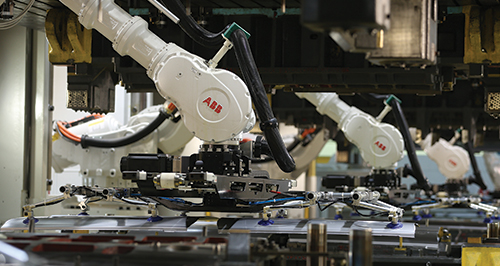 Long the purview of automotive OEMs and Tier Ones, robotic press tending has filtered to lower-tier suppliers not only in automotive, but across sectors including appliance and general industrial. Why? As Toni Roda, global product manager-press automation for ABB points out, the flexible robots of today better interact with presses and other machinery, offer reliability in harsh environments, and can be designed, integrated, programmed and operated more quickly and at lower cost. We’ll detail all of that, but deciding when and where to incorporate robots for tending presses and workcells deserves an initial look.
Long the purview of automotive OEMs and Tier Ones, robotic press tending has filtered to lower-tier suppliers not only in automotive, but across sectors including appliance and general industrial. Why? As Toni Roda, global product manager-press automation for ABB points out, the flexible robots of today better interact with presses and other machinery, offer reliability in harsh environments, and can be designed, integrated, programmed and operated more quickly and at lower cost. We’ll detail all of that, but deciding when and where to incorporate robots for tending presses and workcells deserves an initial look. 